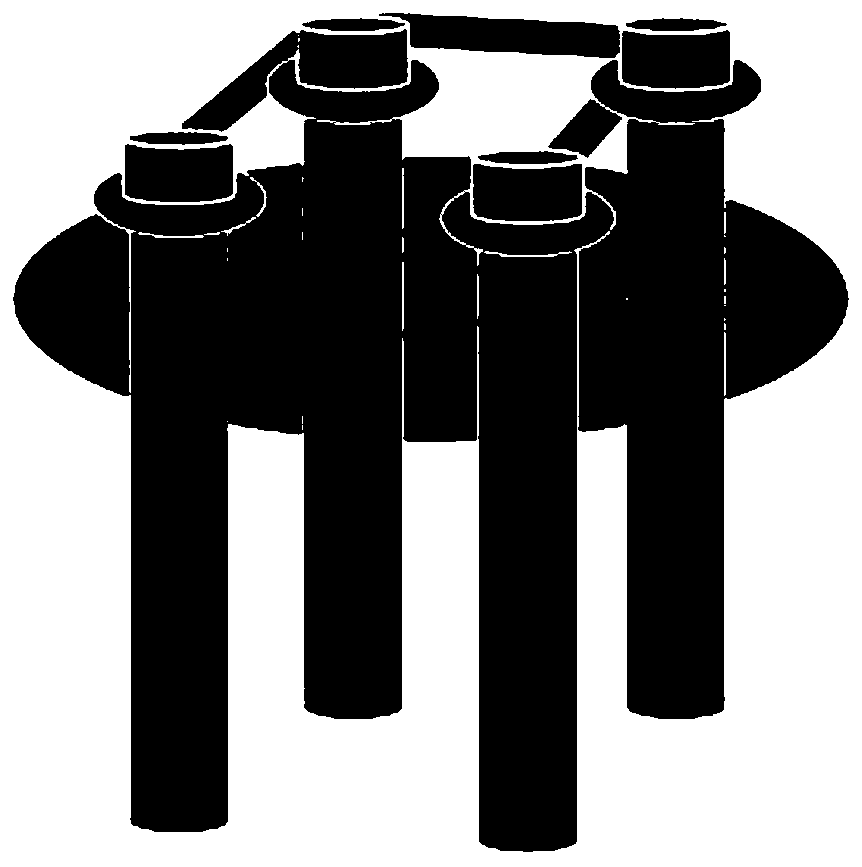AchE/GQDs/N-F-TiO2Ns photoelectrochemical biosensor preparation method and application thereof
A biosensor and photoelectrochemical technology, applied in the field of electrochemical analysis, can solve the problems of high price and achieve the effect of increasing photocurrent, increasing signal and inhibiting recombination rate
- Summary
- Abstract
- Description
- Claims
- Application Information
AI Technical Summary
Problems solved by technology
Method used
Image
Examples
Embodiment 1
[0040] Preparation of AchE / GQDs / N-F-TiO 2 Ns photoelectrochemical biosensor
[0041] Step 1: Preparation of N-F-TiO by Electrochemical Anodization Technology 2 Ns electrode
[0042] Before anodizing, first polish the titanium sheet with different sandpaper, then immerse the titanium sheet in distilled water for 10 minutes and ultrasonically clean it with acetone, absolute ethanol, and double distilled water in turn, and ultrasonically clean it for 10 minutes in each substance, and then put the The clean titanium sheet is immersed in the mixed solution of hydrofluoric acid and nitric acid for 1min. The volume ratio of the mixed solution is V(HF):V(HNO 3 ): V(H 2 (0)=1:4:5, and then the titanium sheet was rinsed with acetone and distilled water, and dried under a nitrogen atmosphere.
[0043] Graphite carbon rods are used as graphite electrode materials, cut to its radius r=0.4cm, length l=5.5cm, and prepare 4 graphite carbon rods of the same specification. Then wrap one en...
Embodiment 2
[0055] AchE / GQDs / N-F-TiO 2 Photocurrent Response of Ns Photoelectrochemical Biosensor to ATCl
[0056] Acetylthiocholine chloride (ATCl) can be used as the substrate of AchE to catalyze the hydrolysis, and the product is thiocholine (TCh), and TCh can be used as a donor of electron sacrifice, and theoretically, an oxidation reaction occurs on the hole, effectively Capture photogenerated holes, inhibit the recombination rate of photogenerated holes and photogenerated electrons, thereby increasing the photocurrent and increasing the amplified signal. Apply ATCl to the AchE / GQDs / N-F-TiO prepared in Example 12 On the Ns photoelectrochemical biosensor, it is verified whether the biosensor of the present invention can have a current response.
[0057] With the AchE / GQDs / N-F-TiO prepared in embodiment 1 2 The Ns photoelectrochemical biosensor is the working electrode, the saturated calomel electrode is the reference electrode, and the platinum wire is the auxiliary electrode. The v...
Embodiment 3
[0060] AchE / GQDs / N-F-TiO 2 Detection of the Inhibitory Effect of Ketamine on AchE by Ns Photoelectrochemical Biosensor
[0061] AchE / GQDs / N-F-TiO prepared with embodiment 1 2 The Ns photoelectrochemical biosensor is the working electrode, the saturated calomel electrode is the reference electrode, and the platinum wire is the auxiliary electrode. The voltage of the working electrode in the photoelectrochemical cell is set to +0.6V, at a wavelength of 365nm, in phosphoric acid at pH=7.00 In salt buffer solution, with 500W xenon lamp as light source, using chronoamperometry, according to AchE / GQDs / N-F-TiO 2 The photocurrent change of ATCl when there is ketamine in the Ns photoelectrochemical biosensor to explore the inhibition of ketamine on AchE.
PUM
| Property | Measurement | Unit |
|---|---|---|
| Concentration | aaaaa | aaaaa |
Abstract
Description
Claims
Application Information
 Login to View More
Login to View More - R&D
- Intellectual Property
- Life Sciences
- Materials
- Tech Scout
- Unparalleled Data Quality
- Higher Quality Content
- 60% Fewer Hallucinations
Browse by: Latest US Patents, China's latest patents, Technical Efficacy Thesaurus, Application Domain, Technology Topic, Popular Technical Reports.
© 2025 PatSnap. All rights reserved.Legal|Privacy policy|Modern Slavery Act Transparency Statement|Sitemap|About US| Contact US: help@patsnap.com



